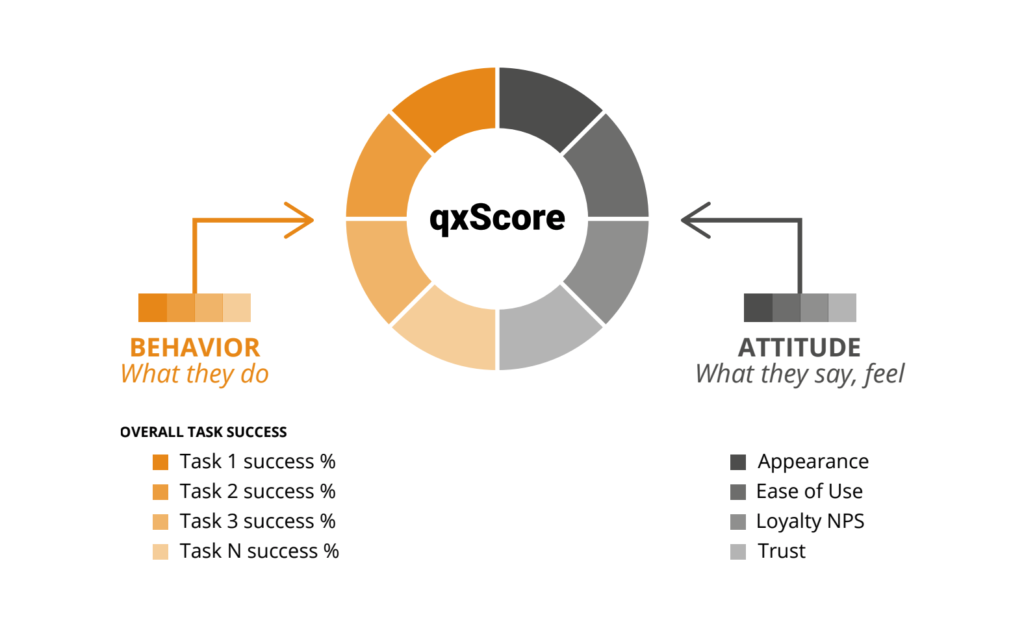UX KPIs
UX KPIs means key performance indicators of user experience, which helps to reflect the overall goal of a product or a website. With UX KPIs, user experience becomes tangible and measurable. UX KPIs are divided into two main categories, which are behavioral UX KPIs and Attitudinal UX KPIs.

Behavioural UX KPIs measure what do users do with a product or a website and whether they can conduct every step successfully or not. Task-based tests are always being used in the methods. The tasks don’t have to be conducted in a lab. It can also be remote user testing. There are serval aspects that should be considered when using these KPIs, such as abandonment rate, page views, problem and frustrations, task success and task time.
Attitudinal UX KPIs measure what do users say and feel, which is a method to ‘qualify’ qualitative data. Four aspects should be considered in this method- appearance, usability, credibility, and loyalty. Appearance indicates the aesthetic value of a web page. Whether the colors are harmonious; if the size and fonts of letters are appropriate and if the information on the page is readable and understandable. Usability measures whether the website is ease of use or not. Credibility means trust. Loyalty can be measured by System Usability Scale (SUS), Net Promoter Score (NPS). SUS is a test for a user to conduct after a certain task in order to evaluate how they found using the whole system. For example, a question can be framed as ‘Whether the website has a user-friendly interface?’ Then, a five points Likert Scale can be given for the user to rate their experience from strongly agree to strongly disagree. NPS identifies the percentage of indicators and detractors. For instance, users will be asked: ‘How likely is it that you would recommend this system/application/website to a friend or colleague?’ Then a 10 points scale will be given from the point of not at all likely to the point of extremely likely. In this scale, users who select points 0 to 6 will be category as detractors; those who select 7 or 9 will be sort as passive users and those who select 9 or 10 are promoters.
Relationship between UX metrics and KPIs
UX KPIs reflect the overall goal of a product or a website whereas UX metrics quantify these goals.
UX metrics
UX metrics are qualitative methods to measure, compare and analyze user experience data when users using an application or a website. Those metrics help UX experts to identify problems in order to improve their products or website by providing quantitative results of user experiences. Nowadays, technology helps to gather data automatically, such as cookies, which improve the efficiency of the data collecting process.
PULSE Metrics

PULSE Metrics is more insightful than NPS and SUS methodologies mentioned before. It is metrics that measure performances of technical and business aspects of large-scale web products. The P is pageviews which measure the number of pages viewed by a single user; U is latency which measures the amount of time it takes data to travel from one location to another; S is seven-day active users, which identify the volume of users who interact with the site or app within the last seven days; finally, E is earnings, which measures revenue generated by the website or product.
However, there are some drawbacks to this methodology. It might give vague indicators of user experience. For example, if a user stays on a page for 10 minutes, which can be interpreted as either the user is interested in the content of the pages or the user is confused by it. Seven-day active users can be an unclear indicator for it not provide the frequency of the user using the webpage. Besides, it is hard to distinguish the new users and existed users.
Conclusion
In conclusion, UX metrics quantify goals that reflected by UX KPIs. PULSE Metrics help identify the performance of large-scale web products but the drawbacks can be an unclear interpretation of user experience. Each method has pros and cons. Thus, it is important to clarify your goals before choosing UX metrics to measure a product or webpage.
